Seismic Vulnerability Assessment in Ranau, Sabah, Using Two Different Models
Abstract
:1. Introduction
2. Materials and Methods
2.1. Study Area
2.2. Conditional Factors
2.2.1. Physical Indicators
2.2.2. Environmental Indicators
2.3. Application of Frequency Ratio (FR) Model
2.4. Implementation of Index of Entropy (IoE)
2.5. Implementing Frequency Ratio-Index of Entropy (FR-IoE) with Analytical Hierarchical Process (AHP)
2.5.1. The AHP Pairwise Comparisons Methodologies
2.5.2. Final Weightage Computation
3. Results
3.1. Assessment of the FR-IoE Model and (FR-IoE) AHP Model
3.1.1. Analysis of the FR-IoE Model and (FR-IoE) AHP Model
3.1.2. Assessment on the FR-IoE Model and (FR-IoE) AHP Model Conditional Factors and Classes
3.2. Seismic Vulnerability Maps
3.3. Model Validation
4. Discussion
4.1. Tectonic Settings and Their Importance to Seismic Vulnerability Assessment in Ranau, Sabah
4.2. Seismic Vulnerability Studies in the Study Area
4.3. Comparisons with Past Research on the Seismic Vulnerability Assessment
4.4. Relevance and Output of the Studies
5. Conclusions
Author Contributions
Funding
Acknowledgments
Conflicts of Interest
References
- Yan, A.S.; Saim Suratman, A.L. Study on the Seismic and Tsunami Hazards and Risks in Malaysia. In Report on the Geological and Seismotectonic Information of Malaysia, Kuala Lumpur, Ministry of Natural Resources and Environment; 2006. [Google Scholar]
- Bakar, R.B.; Jamaluddin, T.A.; Ramli, Z.; Mohamad, Z.; Tongkul, F. Remotely Sensed Geospatial Analysis towards Disaster Preparedness: A Case Study in Malaysia Tectonically Active Earthquake Zone, Ranau, Sabah. FIG Work. Week. Recov. Disaster. 2016, 15, 868–877. [Google Scholar]
- Malaysian Meteorological Department. Seismicity in Malaysia. Available online: http://www.met.gov.my/in/web/metmalaysia/education/earthquakeandtsunami/seismicityinmalaysiaandaroundtheregion (accessed on 20 December 2017).
- Cheng, K.H. Plate Tectonics and Seismic Activities in Sabah Area. Trans. Sci. Technol. 2016, 3, 47–58. [Google Scholar]
- Khalil, A.E.; Abir, I.A.; Hafiez, H.E.A.; Ginsos, H.; Khan, M.S. Probabilistic Seismic Hazards Assessments of Sabah, East Malaysia: Accounting for Local Earthquake Activity Near Ranau. J. Geophys. Eng. 2017, 15, 13–25. [Google Scholar] [CrossRef] [Green Version]
- Harith, N.S.H.; Adnan, A.; Tongkul, F.; Shoushtari, A.V. Analysis on Earthquake Databases of Sabah Region and Its Application for Seismic Design. Int. J. Civil. Eng. Geo-Environ. 2017, 8, 1–5. [Google Scholar]
- Mansor, M.N.A.; Siang, L.C.; Ahwang, A.; Saadun, M.A.; Dumatin, J. Vulnerability Study of Existing Buildings Due to Seismic Activities in Sabah. ISSN:21802742. Available online: http://ijceg.ump.edu.my (accessed on 21 April 2021).
- Sali, A.; Zainal, D.; Ahmad, N.T.; Omar, M.F. Satellite Application for Felt Earthquake Events in Sabah, Malaysia. Int. J. Environ. Sci. Dev. 2017, 8, 153. [Google Scholar] [CrossRef] [Green Version]
- Devkota, K.C.; Regmi, A.D.; Pourghasemi, H.R.; Yoshida, K.; Pradhan, B.; Ryu, I.C.; Dhital, M.R.; Althuwaynee, O.F. Landslide Susceptibility Mapping Using Certainty Factor, Index of Entropy and Logistic Regression Models in GIS And Their Comparison at Mugling–Narayanghat Road Section in Nepal Himalaya. Nat. Hazar. 2013, 65, 135–165. [Google Scholar] [CrossRef]
- Jaafari, A.; Najafi, A.; Pourghasemi, H.R.; Rezaeian, J.; Sattarian, A. GIS-based Frequency Ratio and Index of Entropy Models for Landslide Susceptibility Assessment in the Caspian Forest, Northern Iran. Int. J. Environ. Sci. Technol. 2014, 11, 909–926. [Google Scholar] [CrossRef] [Green Version]
- Liu, J.; Duan, Z. Quantitative Assessment of Landslide Susceptibility Comparing Statistical Index, Index of Entropy, And Weights of Evidence in the Shangnan Area, China. Entropy 2018, 20, 868. [Google Scholar] [CrossRef] [Green Version]
- Park, S.; Choi, C.; Kim, B.; Kim, J. Landslide Susceptibility Mapping Using Frequency Ratio, Analytic Hierarchy Process, Logistic Regression, and Artificial Neural Network Methods at the Inje Area, Korea. Environ. Earth Sci. 2013, 68, 1443–1464. [Google Scholar] [CrossRef]
- Pradhan, B.; Lee, S. Delineation of Landslide Hazard Areas on Penang Island, Malaysia, by Using Frequency Ratio, Logistic Regression, and Artificial Neural Network Models. Environ. Earth Sci. 2010, 60, 1037–1054. [Google Scholar] [CrossRef]
- Cabal, A.; Coulet, C.; Erlich, M.; Cossalter, A.; David, E.; Sauvaget, P.; Maria Polese, A.E.E.; Zuccaro, G.; Alten, K.; Steinnocher, K.; et al. Existing Hazard and Vulnerability/Losses Models. Available online: https://www.researchgate.net/profile/Maria-Polese/publication/283307151_Models_for_MultiSectoral_Consequences_Existing_hazard_and_vulnerability_losses_models/links/56372f7e08ae88cf81bd4f89/Models-for-Multi-Sectoral-Consequences-Existing-hazard-and-vulnerability-losses-models.pdf (accessed on 6 April 2021).
- Van Westen, C.J. Introduction to Exposure, Vulnerability and Risk Assessment. 2020. Available online: http://www.charim.net/methodology/51 (accessed on 7 April 2021).
- Duzgun, H.S.B.; Yucemen, M.S.; Kalaycioglu, H.S.; Celik, K.; Kemec, S.; Ertugay, K.; Deniz, A. An Integrated Earthquake Vulnerability Assessment Framework for Urban Areas. Nat. Hazar. 2011, 59, 917–947. [Google Scholar] [CrossRef]
- Yariyan, P.; Avand, M.; Soltani, F.; Ghorbanzadeh, O.; Blaschke, T. Earthquake Vulnerability Mapping Using Different Hybrid Models. Symmetry 2020, 12, 405. [Google Scholar] [CrossRef] [Green Version]
- Jena, R.; Pradhan, B.; Naik, S.P.; Alamri, A.M. Earthquake Risk Assessment in NE India Using Deep Learning and Geospatial Analysis. Geosci. Front. 2021, 12, 10111. [Google Scholar] [CrossRef]
- Toyfur, M.F.; Pribadi, K.S.; Wibowo, S.S.; Sengara, I.W. Vulnerability Factor in Earthquake Risk Assessment Model for Roads in Indonesia. EDP Sci. MATEC Web Conf. 2018, 229, 03009. [Google Scholar] [CrossRef] [Green Version]
- Nazmfar, H.; Saredeh, A.; Eshgi, A.; Feizizadeh, B. Vulnerability Evaluation of Urban Buildings to Various Earthquake Intensities: A Case Study of the Municipal Zone 9 of Tehran. Hum. Ecol. Risk Assess. Int. J. 2019, 25, 455–474. [Google Scholar] [CrossRef]
- Han, J.; Park, S.; Kim, S.; Son, S.; Lee, S.; Kim, J. Performance of Logistic Regression and Support Vector Machines for Seismic Vulnerability Assessment and Mapping: A Case Study of the 12 September 2016 ML5. 8 Gyeongju Earthquake, South Korea. Sustainability 2019, 11, 7038. [Google Scholar] [CrossRef] [Green Version]
- Saputra, A.; Rahardianto, T.; Revindo, M.D.; Delikostidis, I.; Hadmoko, D.S.; Sartohadi, J.; Gomez, C. Seismic Vulnerability Assessment of Residential Buildings using Logistic Regression and Geographic Information System (GIS) in Pleret Sub District (Yogyakarta, Indonesia). Geoenviron. Disasters 2017, 4, 1–33. [Google Scholar] [CrossRef] [Green Version]
- Alizadeh, M.; Alizadeh, E.; Asadollahpour, K.S.; Shahabi, H.; Beiranvand Pour, A.; Panahi, M.; Bin Ahmad, B.; Saro, L. Social Vulnerability Assessment Using Artificial Neural Network (ANN) Model for Earthquake Hazard in Tabriz City, Iran. Sustainability 2018, 10, 3376. [Google Scholar] [CrossRef] [Green Version]
- Alizadeh, M.; Ngah, I.; Hashim, M.; Pradhan, B.; Pour, A.B. A Hybrid Analytic Network Process and Artificial Neural Network (ANP-ANN) Model for Urban Earthquake Vulnerability Assessment. Remote Sens. 2018, 10, 975. [Google Scholar] [CrossRef] [Green Version]
- Han, J.; Kim, J.; Park, S.; Son, S.; Ryu, M. Seismic Vulnerability Assessment and Mapping of Gyeongju, South Korea Using Frequency Ratio, Decision Tree, and Random Forest. Sustainability 2020, 12, 7787. [Google Scholar] [CrossRef]
- Lee, S.; Panahi, M.; Pourghasemi, H.R.; Shahabi, H.; Alizadeh, M.; Shirzadi, A.; Khosravi, K.; Melesse, A.M.; Yekrangnia, M.; Rezaie, F.; et al. SEVUCAS: A Novel GIS-Based Machine Learning Software for Seismic Vulnerability Assessment. Appl. Sci. 2019, 9, 3495. [Google Scholar] [CrossRef] [Green Version]
- Chen, W.; Li, W.; Hou, E.; Bai, H.; Chai, H.; Wang, D.; Cui, X.; Wang, Q. Application of Frequency Ratio, Statistical Index, and Index of Entropy Models and Their Comparison in Landslide Susceptibility Mapping for the Baozhong Region of Baoji, China. Arab. J. Geosci. 2015, 8, 1829–1841. [Google Scholar] [CrossRef]
- Wang, Y.; Fang, Z.; Hong, H.; Costache, R.; Tang, X. Flood Susceptibility Mapping by Integrating Frequency Ratio and Index of Entropy with Multilayer Perceptron and Classification and Regression Tree. J. Environ. Manag. 2021, 289, 112449. [Google Scholar] [CrossRef] [PubMed]
- Wang, Q.; Li, W.; Yan, S.; Wu, Y.; Pei, Y. GIS Based Frequency Ratio and Index of Entropy Models to Landslide Susceptibility Mapping (Daguan, China). Environ. Earth Sci. 2016, 75, 780. [Google Scholar] [CrossRef]
- Ranau District Office. Latar Belakang Daerah Ranau. 2019. Available online: http://ww2.sabah.gov.my/pd.rnu/sejarah.html (accessed on 3 January 2019).
- Department of Statistics, Malaysia. Population Distribution by Local Authority Areas and Mukims. 2010. Available online: https://www.mycensus.gov.my/index.php/census-product/publication/census-2010/681-population-distribution-by-local-authority-and-mukims-2010 (accessed on 2 January 2019).
- Tongkul, F. Active Tectonics in Sabah—Seismicity and Active Faults. Bull. Geol. Soc. Malays. 2017, 64, 27–36. [Google Scholar] [CrossRef] [Green Version]
- Tongkul, F. The 2015 Ranau Earthqauke: Cause and Impact. Sabah Soc. J. 2016, 32, 1–28. [Google Scholar]
- Sarris, A.; Loupasakis, C.; Soupios, P.; Trigkas, V.; Vallianatos, F. Earthquake Vulnerability and Seismic Risk Assessment of Urban Areas in High Seismic Regions: Application to Chania City, Crete Island, Greece. Nat. Hazards 2010, 54, 395–412. [Google Scholar] [CrossRef]
- Caliskan, S.; Taubenböck, H.; Hinz, S.; Roth, A. Earthquake Vulnerability Indicators and Vulnerability Assessment Using Remote Sensing, Istanbul. 2006. 1st EARSeL Workshop SIG Urban. Remote Sens. Berlin, Germany. Available online: https://www.researchgate.net/publication/224798942 (accessed on 8 April 2021).
- Aliabadi, S.F.; Sarsangi, A.; Modiri, E. The Social and Physical Vulnerability Assessment of Old Texture against Earthquake (Case Study: Fahadan District in Yazd City). Arab. J. Geosci. 2015, 8, 10775–10787. [Google Scholar] [CrossRef]
- Ayalew, L.; Yamagishi, H. The Application of GIS-Based Logistic Regression for Landslide Susceptibility Mapping in The Kakuda-Yahiko Mountains, Central Japan. Geomorphology 2005, 65, 15–31. [Google Scholar] [CrossRef]
- Pavić, G.; Bulajić, B.; Hadzima-Nyarko, M. The Vulnerability of Buildings from the Osijek Database. Front. Built. Environ. 2019, 5, 66. [Google Scholar] [CrossRef] [Green Version]
- Kontogianni, V.; Pytharouli, S.; Stiros, S. Ground Subsidence, Quaternary Faults and Vulnerability of Utilities and Transportation Networks in Thessaly, Greece. Environ. Geol. 2007, 52, 1085–1095. [Google Scholar] [CrossRef]
- Kermanshah, A.; Derrible, S. A Geographical and Multi-Criteria Vulnerability Assessment of Transportation Networks against Extreme Earthquakes. Reliabil. Eng. Syst. Safety 2016, 153, 39–49. [Google Scholar] [CrossRef]
- Pachauri, A.K.; Pant, M. Landslide Hazard Mapping Based on Geological Attributes. Eng. Geol. 1992, 32, 81–100. [Google Scholar] [CrossRef]
- Rodrıguez, C.E.; Bommer, J.J.; Chandler, R.J. Earthquake-induced Landslides: 1980–1997. Soil Dynam. Earthq. Eng. 1999, 18, 325–346. [Google Scholar] [CrossRef]
- Bommer, J.J.; Rodrı́guez, C.E. Earthquake-induced Landslides in Central America. Eng. Geol. 2002, 63, 189–220. [Google Scholar] [CrossRef]
- Ren, D.; Wang, J.; Fu, R.; Karoly, D.J.; Hong, Y.; Leslie, L.M.; Fu, C.; Huang, G. Mudslide-caused Ecosystem Degradation Following Wenchuan Earthquake 2008. Geophys. Res. Lett. 2009, 36. [Google Scholar] [CrossRef]
- Wang, H.B.; Sassa, K.; Xu, W.Y. Analysis of a Spatial Distribution of Landslides Triggered by the 2004 Chuetsu Earthquakes of Niigata Prefecture, Japan. Nat. Hazards 2007, 41, 43. [Google Scholar] [CrossRef]
- USGS. Ground Shaking Simulations: Background. 2020. Available online: https://earthquake.usgs.gov/education/shakingsimulations/background.php (accessed on 13 December 2020).
- Tang, C.; Zhu, J.; Li, W.L.; Liang, J.T. Rainfall-triggered Debris Flows Following the Wenchuan Earthquake. Bull. Eng. Geol. Environ. 2009, 68, 187–194. [Google Scholar] [CrossRef]
- Ujiie, K.; Kimura, G. Earthquake Faulting in Subduction Zones: Insights from Fault Rocks in Accretionary Prisms. Prog. Earth Planet. Sci. 2014, 1, 7. [Google Scholar] [CrossRef] [Green Version]
- Earle, S. Physical Geology. Victoria, B.C.: BCcampus. 2015. Available online: https://opentextbc.ca/geology/ (accessed on 22 February 2021).
- Potter, S.H.; Becker, J.S.; Johnston, D.M.; Rossiter, K.P. An Overview of the Impacts of the 2010–2011 Canterbury Earthquakes. Int. J. Disaster Risk Reduct. 2015, 14, 6–14. [Google Scholar] [CrossRef] [Green Version]
- Jibson, R.W. Methods for Assessing the Stability of Slopes During Earthquakes—A Retrospective. Eng. Geol. 2011, 122, 43–50. [Google Scholar] [CrossRef]
- Hack, R.; Alkema, D.; Kruse, G.A.; Leenders, N.; Luzi, L. Influence of Earthquakes on the Stability of Slopes. Eng. Geol. 2007, 91, 4–15. [Google Scholar] [CrossRef]
- Umar, Z.; Pradhan, B.; Ahmad, A.; Jebur, M.N.; Tehrany, M.S. Earthquake Induced Landslide Susceptibility Mapping Using an Integrated Ensemble Frequency Ratio and Logistic Regression Models in West Sumatera Province, Indonesia. Catena 2014, 118, 124–135. [Google Scholar] [CrossRef]
- Lee, S.; Pradhan, B. Landslide hazard mapping at Selangor, Malaysia using frequency ratio and logistic regression models. Landslides 2007, 4, 33–41. [Google Scholar] [CrossRef]
- Nohani, E.; Moharrami, M.; Sharafi, S.; Khosravi, K.; Pradhan, B.; Pham, B.T.; Lee, S.; Melesse, A. Landslide susceptibility mapping using different GIS-based bivariate models. Water 2019, 11, 1402. [Google Scholar] [CrossRef] [Green Version]
- Yalcin, A.; Reis, S.; Aydinoglu, A.C.; Yomralioglu, T. A GIS-based comparative study of frequency ratio, analytical hierarchy process, bivariate statistics and logistics regression methods for landslide susceptibility mapping in Trabzon, NE Turkey. Catena 2011, 85, 274–287. [Google Scholar] [CrossRef]
- Regmi, A.D.; Devkota, K.C.; Yoshida, K.; Pradhan, B.; Pourghasemi, H.R.; Kumamoto, T.; Akgun, A. Application of Frequency Ratio, Statistical Index, and Weights-of-Evidence Models and Their Comparison in Landslide Susceptibility Mapping in Central Nepal Himalaya. Arab. J. Geosci. 2014, 7, 725–742. [Google Scholar] [CrossRef]
- Bednarik, M.; Yilmaz, I.; Marschalko, M. Landslide Hazard and Risk Assessment: A Case Study from the Hlohovec–Sered’landslide Area in South-west Slovakia. Nat. Hazards 2012, 64, 547–575. [Google Scholar] [CrossRef]
- Can, T.; Nefeslioglu, H.A.; Gokceoglu, C.; Sonmez, H.; Duman, T.Y. Susceptibility Assessments of Shallow Earthflows Triggered by Heavy Rainfall at Three Catchments by Logistic Regression Analyses. Geomorphology 2005, 72, 250–271. [Google Scholar] [CrossRef]
- Constantin, M.; Bednarik, M.; Jurchescu, M.C.; Vlaicu, M. Landslide Susceptibility Assessment Using the Bivariate Statistical Analysis and The Index of Entropy in the Sibiciu Basin (Romania). Environ. Earth Sci. 2011, 63, 397–406. [Google Scholar] [CrossRef]
- Dai, F.C.; Lee, C.F.; Zhang, X.H. GIS-Based Geo-Environmental Evaluation for Urban Land-Use Planning: A Case Study. Eng. Geol. 2001, 61, 257–271. [Google Scholar] [CrossRef]
- Sharma, L.P.; Patel, N.; Ghose, M.K.; Debnath, P. Influence of Shannon’s Entropy on Landslide-causing Parameters for Vulnerability Study and Zonation—A Case Study in Sikkim, India. Arab. J. Geosci. 2012, 5, 421–431. [Google Scholar] [CrossRef]
- Bednarik, M.; Magulová, B.; Matys, M.; Marschalko, M. Landslide Susceptibility Assessment of the Kraľovany–Liptovský Mikuláš Railway Case Study. Phys. Chem. Earth Parts A/B/C 2010, 35, 162–171. [Google Scholar] [CrossRef]
- Saaty, T.L. A Scaling Method for Priorities in Hierarchical Structures. J. Math. Psychol. 1977, 15, 234–281. [Google Scholar] [CrossRef]
- Rezaei, A.; Tahsili, S. Urban Vulnerability Assessment Using AHP. Adv. Civil. Eng. 2018, 62. [Google Scholar] [CrossRef] [Green Version]
- Saaty, T.L. The Analytic Hierarchy Process; McGraw-Hill: New York, NY, USA, 1980. [Google Scholar]
- Saaty, L. An Analytical Hierarchy and Network Processes Approach for the Measurement in Tangible Criteria and for Decision Making; Multiple Criteria Decision. State Art Survey 2005, 345–406. [Google Scholar]
- Keshavarzi, A.; Sarmadian, F.; Heidari, A.; Omid, M. Land Suitability Evaluation Using Fuzzy Continuous Classification (A Case Study: Ziaran Region). Mod. Appl. Sci. 2010, 4, 72. [Google Scholar] [CrossRef] [Green Version]
- Saaty, T.L. Decision-making with the AHP: Why is the Principal Eigenvector Necessary? Eur. J. Oper. Res. 2003, 145, 85–91. [Google Scholar] [CrossRef]
- Vahidnia, M.H.; Alesheikh, A.; Alimohammadi, A.; Bassiri, A. Fuzzy analytical hierarchy process in GIS application. Int. Arch. Photogram. Remote Sens. Spatial Inform. Sci. 2008, 37, 593–596. [Google Scholar]
- Alizadeh, M.; Hashim, M.; Alizadeh, E.; Shahabi, H.; Karami, M.R.; Beiranvand Pour, A.; Zabihi, H. Multi-Criteria Decision Making (MCDM) Model for Seismic Vulnerability Assessment (SVA) of Urban Residential Buildings. ISPRS Int. J. Geo-Inform. 2018, 7, 444. [Google Scholar] [CrossRef] [Green Version]
- Saaty, T.L. What is the Analytic Hierarchy Process? In Mathematical Models for Decision; Springer: Berlin/Heidelberg, Germany, 1988; pp. 109–121. [Google Scholar]
- Saaty, T.L. How to Make a Decision: The Analytic Hierarchy Process. Eur. J. Oper. Res. 1990, 48, 9–26. [Google Scholar] [CrossRef]
- Saaty, R.W. The Analytic Hierarchy Process—What It Is and How It Is Used. Math. Model. 1987, 9, 161–176. [Google Scholar] [CrossRef] [Green Version]
- Saaty, T.L.; Tran, L.T. On the Invalidity of Fuzzifying Numerical judgments in the Analytic Hierarchy Process. Math. Comput. Model. 2007, 46, 962–975. [Google Scholar] [CrossRef]
- Bijukchhen, S.M.; Kayastha, P.; Dhital, M.R. A Comparative Evaluation of Heuristic and Bivariate Statistical Modelling for Landslide Susceptibility Mappings in Ghurmi–Dhad Khola, East Nepal. Arab. J. Geosci. 2013, 6, 2727–2743. [Google Scholar] [CrossRef]
- Ródenas, J.L.; García-Ayllón, S.; Tomás, A. Estimation of the Buildings Seismic Vulnerability: A Methodological Proposal for Planning Ante-Earthquake Scenarios in Urban Areas. Appl. Sci. 2018, 8, 1208. [Google Scholar] [CrossRef] [Green Version]
- Kegyes-Brassai, O. Vulnerability Assessment of Buildings Based on Rapid Visual Screening and Pushover: Case Study of Gyor, Hungary. Comput. Methods Exp. Measure. XIX Earthq. Resist. Eng. Struct. XII 2019, 185, 63–74. [Google Scholar]
- Khademi, N.; Balaei, B.; Shahri, M.; Mirzaei, M.; Sarrafi, B.; Zahabiun, M.; Mohaymany, A.S. Transportation Network Vulnerability Analysis for The Case of a Catastrophic Earthquake. Int. J. Disaster Risk Reduct. 2015, 12, 234–254. [Google Scholar] [CrossRef]
- Dou, J.; Bui, D.T.; Yunus, A.P.; Jia, K.; Song, X.; Revhaug, I.; Xia, H.; Zhu, Z. Optimization of Causative Factors for Landslide Susceptibility Evaluation Using Remote Sensing and GIS Data in Parts of Niigata, Japan. PLoS ONE 2015, 10, 0133262. [Google Scholar] [CrossRef] [Green Version]
- Yusoff, H.H.M.; Razak, K.A.; Yuen, F.; Harun, A.; Talib, J.; Mohamad, Z.; Ramli, Z.; Abd Razab, R. Mapping of Post-Event Earthquake Induced Landslides in Sg. Mesilou Using LiDAR. IOP Conf. Series Earth Environ. Sci. 2016, 37, 012068. [Google Scholar] [CrossRef] [Green Version]
- Abd Razak, S.M.S.; Adnan, A.; Abas, M.R.C.; Lin, W.S.; Zainol, N.Z.; Yahya, N.; Rizalman, A.N.; Mohamad, M.E. A Historical Review of Significant Earthquakes in Region Surrounding Malaysia. Available online: https://www.researchgate.net/profile/Norrazman-Zaiha-Zainol/publication/327233941_A_HISTORICAL_REVIEW_OF_SIGNIFICANT_EARTHQUAKES_IN_REGION_SURROUNDING_MALAYSIA/links/5b82c82f299bf1d5a7297212/A-HISTORICAL-REVIEW-OF-SIGNIFICANT-EARTHQUAKES-IN-REGION-SURROUNDING-MALAYSIA.pdf (accessed on 27 February 2021).
- Lim, P.S. History of Earthquake Activities in Sabah, 1897–1983. Geol. Survey Malay. Ann. Rep. 1985, 350–357. [Google Scholar]
- Lim, P.S. Seismic Activities in Sabah and Their Relationship to Regional Tectonics. Geol. Survey Malay. Ann. Rep. 1986, 465–480. [Google Scholar]
- Wilford, G.E. Earth Tremors in Sabah. Sabah Soc. J. 1967, 3, 136–138. [Google Scholar]
- Leyu, C.H.; Chang, C.F.; Arnold, E.P.; Kho, S.L.; Lim, Y.T.; Subramaniam, M.; Ong, T.C.; Tan, C.K.; Yap, K.S.; Shu, Y.K.; et al. Southeast Asia Association of Seismology and Earthquake Engineering Series on Seismology—Malaysia. Seismic Seismol. 1985, 3. [Google Scholar]
- Harding, J.S.; Jellyman, P.G. Earthquakes, catastrophic sediment additions and the response of urban stream communities. N. Z. J. Mar. Freshw. Res. 2015, 49, 346–355. [Google Scholar] [CrossRef]
- Ahmad, R.A.; Singh, R.P.; Adris, A. Seismic Hazard Assessment of Syria Using Seismicity, DEM, Slope, Active Faults and GIS. Remote Sens. Appl. Soc. Environ. 2017, 6, 59–70. [Google Scholar] [CrossRef]
- Milledge, D.; Rosser, N.; Oven, K.; Dixit, A.M.; Dhungel, R.; Basyal, G.K.; Adhikari, S.R.; Densmore, A. Simple Guidelines to Minimise Exposure to Earthquake-triggered Landslides. Earthq. Front. Brief. Note 2018. Available online: http://eprints.esc.cam.ac.uk/4298/ (accessed on 20 April 2021).
- Wiranata, F.E. Landslide Vulnerability Analysis Due to Earthquake Based on Seismic Vulnerability and Slope of the Slip Surface in Tritis, Yogyakarta. JFA 2021, 17, 20–24. [Google Scholar] [CrossRef]
- Alinia, H.S.; Delavar, M.R. Tehran’s Seismic Vulnerability Classification using Granular Computing Approach. Appl. Geomat. 2011, 3, 229–240. [Google Scholar] [CrossRef]
- Dahal, B.K.; Dahal, R.K. Landslide Hazard Map: Tool for Optimization of Low-Cost Mitigation. Geoenviron. Disasters 2017, 4, 1–9. [Google Scholar] [CrossRef] [Green Version]
- Yu, X.; Gao, H. A Landslide Susceptibility Map Based on Spatial Scale Segmentation: A Case Study at Zigui-Badong in the Three Gorges Reservoir Area, China. PLoS ONE 2020, 15, 0229818. [Google Scholar] [CrossRef]
- Nwe, Z.Z.; Tun, K.T. Identification of Seismic Vulnerability Zones based on Land Use Condition. Am. Sci. Res. J. Eng. Technol. Sci. (ASRJETS) 2016, 23, 90–102. [Google Scholar]
- Jena, R.; Pradhan, B.; Beydoun, G.; Sofyan, H.; Affan, M. Integrated Model for Earthquake Risk Assessment Using Neural Network and Analytic Hierarchy Process: Aceh Province, Indonesia. Geosci. Front. 2020, 11, 613–634. [Google Scholar] [CrossRef]
- Akgun, A.; Kıncal, C.; Pradhan, B. Application of Remote Sensing Data and GIS for Landslide Risk Assessment as an Environmental Threat to Izmir City (West Turkey). Environ. Monitor. Assess. 2012, 184, 5453–5470. [Google Scholar] [CrossRef]
- Sarkar, S.; Kanungo, D.P.; Patra, A.K.; Kumar, P. GIS Based Spatial Data Analysis for Landslide Susceptibility Mapping. J. Mount. Sci. 2008, 5, 52–62. [Google Scholar] [CrossRef]
- Tien Bui, D.; Pradhan, B.; Lofman, O.; Revhaug, I. Landslide Susceptibility Assessment in Vietnam Using Support Vector Machines, Decision Tree, And Naive Bayes Models. Math. Prob. in Eng. 2012, 1–26. [Google Scholar] [CrossRef] [Green Version]
- Rasyid, A.R.; Bhandary, N.P.; Yatabe, R. Performance of Frequency Ratio and Logistic Regression Model in Creating GIS Based Landslides Susceptibility Map at Lompobattang Mountain, Indonesia. Geoenviron. Disasters 2016, 3, 1–16. [Google Scholar] [CrossRef] [Green Version]
- Ozdemir, A.; Altural, T. A Comparative Study of Frequency Ratio, Weights of Evidence and Logistic Regression Methods for Landslide Susceptibility Mapping: Sultan Mountains, SW Turkey. J. Asian Earth Sci. 2013, 64, 180–197. [Google Scholar] [CrossRef]
- Pourghasemi, H.R.; Pradhan, B.; Gokceoglu, C. Application of Fuzzy Logic and Analytical Hierarchy Process (AHP) to Landslide Susceptibility Mapping at Haraz Watershed, Iran. Nat. Hazards 2012, 63, 965–996. [Google Scholar] [CrossRef]
- Mohammady, M.; Pourghasemi, H.R.; Pradhan, B. Landslide Susceptibility Mapping at Golestan Province, Iran: A Comparison Between Frequency Ratio, Dempster–Shafer, and Weights-of-Evidence Models. J. Asian Earth Sci. 2012, 61, 221–236. [Google Scholar] [CrossRef]
- Unal, I. Defining an Optimal Cut-Point Value in ROC analysis: An Alternative Approach. Comput. Math. Methods Med. 2017, 2017. [Google Scholar] [CrossRef]
- Mandrekar, J.N. Receiver Operating Characteristic Curve in Diagnostic Test Assessment. J. Thor. Oncol. 2010, 5, 1315–1316. [Google Scholar] [CrossRef] [PubMed] [Green Version]
- Tape, T.G. Interpretation of Diagnostic Tests: The Area under an ROC Curve. 2020. Available online: http://gim.unmc.edu/dxtests/roc3.htm (accessed on 19 December 2020).
- Hutchison, C.S. Geology of North-West Borneo. Elsevier B.V. 2005, 421. [Google Scholar]
- Shah, A.A. Understanding the Recent Sabah Earthquake, and Other Seismogenic Sources in North West Borneo. Sci. Malay. 2015, 11, 7–10. [Google Scholar]
- Wang, Y.; Wei, S.; Wang, X.; Lindsey, E.O.; Tongkul, F.; Tapponnier, P.; Bradley, K.; Chan, C.H.; Hill, E.M.; Sieh, K. The 2015 M w 6.0 Mt. Kinabalu earthquake: An Infrequent Fault Rupture within the Crocker Fault System of East Malaysia. Geosci. Lett. 2017, 4, 1–12. [Google Scholar] [CrossRef] [Green Version]
- Petersen, M.; Harmsen, S.; Mueller, C.; Haller, K.; Dewey, J.; Luco, N.; Crone, A.; Lidke, D.; Rukstales, K. Documentation for the Southeast Asia Seismic Hazard Maps. Admin. Rep. 2007, 30. [Google Scholar]
- Katili, J.A. Review of Past and Present Geotectonic Concepts of Eastern Indonesia. N. J. Sea Res. 1989, 24, 103–129. [Google Scholar] [CrossRef]
- Ganasan, R.; Tan, C.G.; Ibrahim, Z.; Nazri, F.M.; Wong, Y.H. A Case Study on Structural Failure of Reinforced Concrete Beam-Column Joint After the First Significant Earthquake Impact in Malaysia. Int. J. Integrated Eng. 2020, 12, 288–302. [Google Scholar] [CrossRef]
- Ghafar, M.; Ramly, N.; Alel, M.; Adnan, A.; Mohamad, E.T.; Yunus, M.Z. A Simplified Method for Preliminary Seismic Vulnerability Assessment of Existing Building in Kundasang, Sabah, Malaysia. J. Teknol. 2015, 72. [Google Scholar] [CrossRef] [Green Version]
- Jainih, V.; Harith, N.S.H. Seismic Vulnerability Assessment in Kota Kinabalu, Sabah. IOP Conf. Series Earth Environ. Sci. 2020, 476, 012053. [Google Scholar] [CrossRef]
- Roslee, F.T.R.; Termizi, A.K.; Indan, E.; Tongkul, F. Earthquake Vulnerability Assessment (EVAs): A Study of Physical Vulnerability Assessment in Ranau area, Sabah, Malaysia. ASM Sci. J. 2018, 11, 66–74. [Google Scholar]
- Ismail, R.; Adnan, A.; Ibrahim, A. Vulnerability of Public Buildings in Sabah Subjected to Earthquake by Finite Element Modelling. Proc. Eng. 2011, 20, 54–60. [Google Scholar] [CrossRef] [Green Version]
- Center, A.D.P. Earthquake Vulnerability Reduction for Cities. Third Regional Training Course on Earthquake Vulnerability Reduction for Cities. Available online: https://pdf4pro.com/cdn/earthquake-vulnerability-concepts-an-22a497.pdf (accessed on 13 April 2021).
- El Jazouli, A.; Barakat, A.; Khellouk, R. GIS-Multicriteria Evaluation Using AHP for Landslide Susceptibility Mapping in Oum Er Rbia High Basin (Morocco). Geoenviron. Disasters. 2019, 6, 1–2. [Google Scholar] [CrossRef]
- Sarkar, D.; Mondal, P. Flood Vulnerability Mapping Using Frequency Ratio (FR) Model: A Case Study on Kulik River Basin, Indo-Bangladesh Barind Region. Appl. Water Sci. 2020, 10, 1–13. [Google Scholar] [CrossRef] [Green Version]
- Oh, H.J.; Lee, S.; Hong, S.M. Landslide Susceptibility Assessment using Frequency Ratio Technique with Iterative Random Sampling. J. Sens. 2017, 2017, 21. [Google Scholar] [CrossRef] [Green Version]
- Arora, A.; Pandey, M.; Siddiqui, M.A.; Hong, H.; Mishra, V.N. Spatial Flood Susceptibility Prediction in Middle Ganga Plain: Comparison of Frequency Ratio and Shannon’s Entropy Models. Geocarto Int. 2019, 1–32. [Google Scholar] [CrossRef]
- Pourtaghi, Z.S.; Pourghasemi, H.R.; Rossi, M. Forest Fire Susceptibility Mapping in The Minudasht Forests, Golestan Province, Iran. Environ. Earth Sci. 2015, 73, 1515–1533. [Google Scholar] [CrossRef]
- Sinaga, T.P.; Nugroho, A.; Lee, Y.W.; Suh, Y. GIS Mapping of Tsunami Vulnerability: Case Study of the Jembrana Regency in Bali, Indonesia. KSCE J. Civil. Eng. 2011, 15, 537–543. [Google Scholar] [CrossRef]
- Suryani, I.; Hermon, D.; Barlian, E.; Dewata, I.; Umar, I. Policy Direction for AHP-Based Disaster Mitigation Education the Post Eruption of Dempo Volcano in Pagar Alam City–Indonesia. Int. J. Manag. Human. (IJMH) 2020, 4, 39–43. [Google Scholar]
- Han, J.; Nur, A.S.; Syifa, M.; Ha, M.; Lee, C.W.; Lee, K.Y. Improvement of Earthquake Risk Awareness and Seismic Literacy of Korean Citizens through Earthquake Vulnerability Map from the 2017 Pohang Earthquake, South Korea. Remote Sens. 2021, 13, 1365. [Google Scholar] [CrossRef]
- Federal Emergency Management Agency (FEMA). NEHRP Recommended Provisions for New Buildings and Other Structures: Training and Instructional Materials. FEMA 451B. 2007. Available online: http://www.ce.memphis.edu/7119/PDFs/FEAM_Notes/Topic01-CourseIntroduction.pdf (accessed on 17 April 2021).
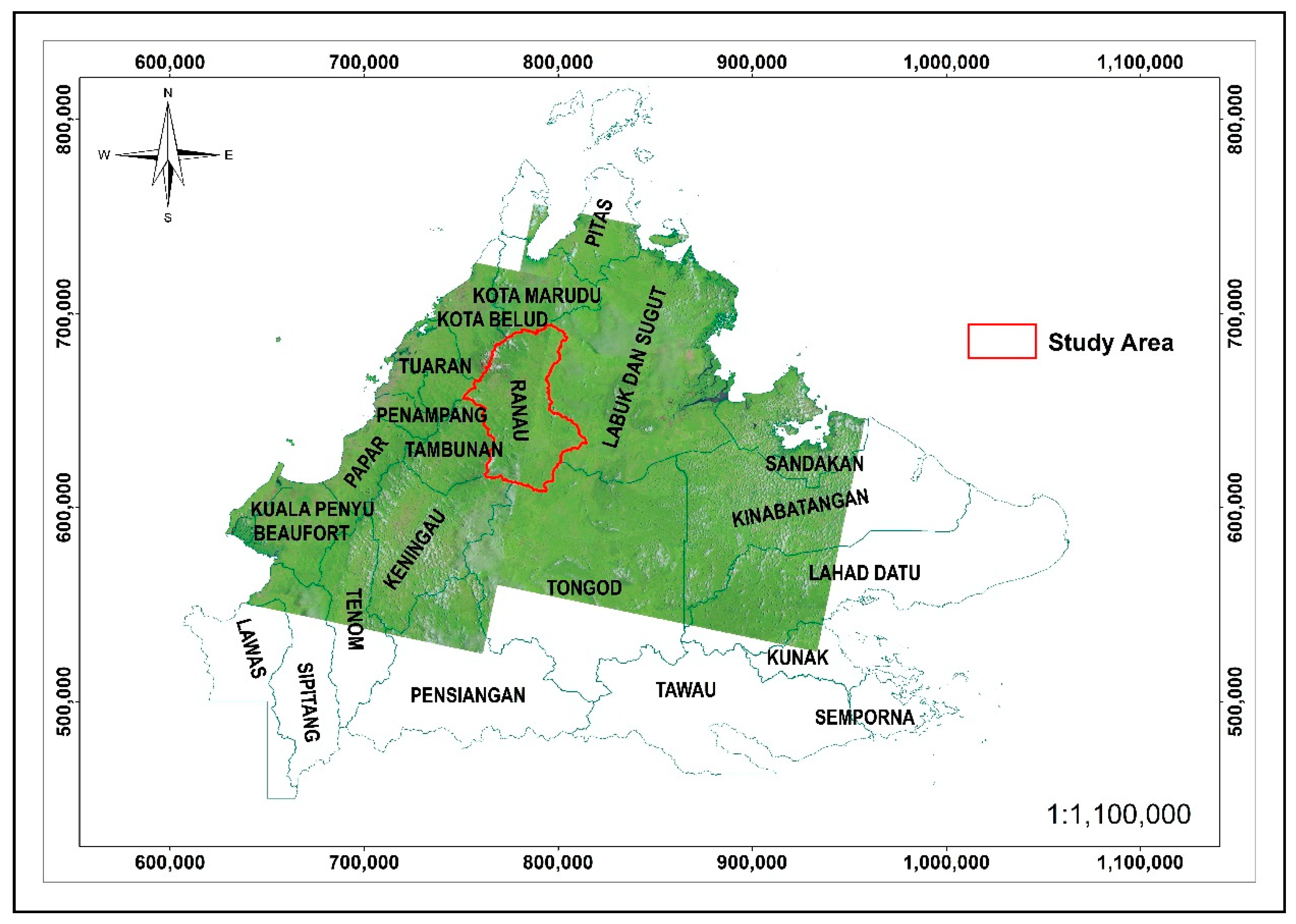
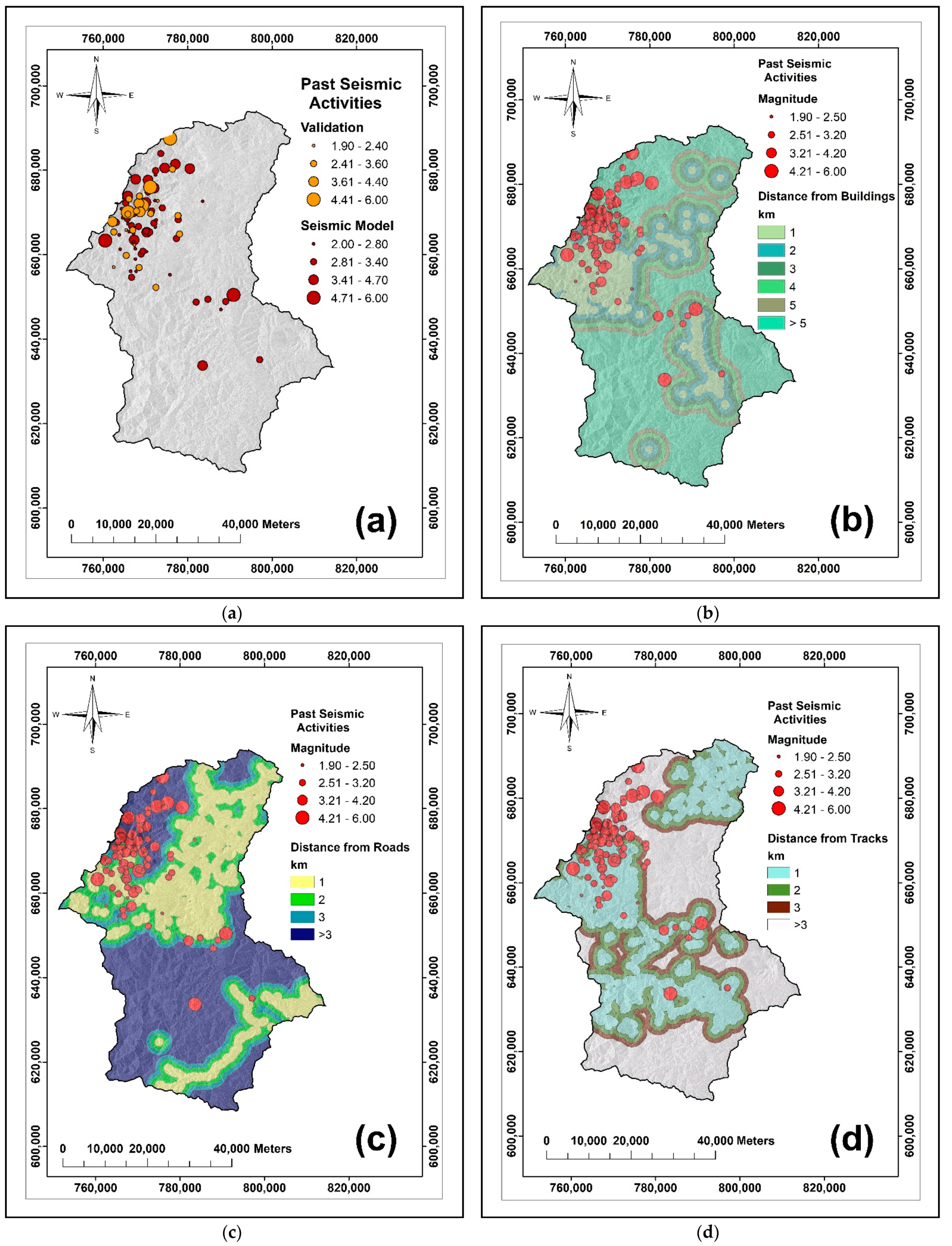
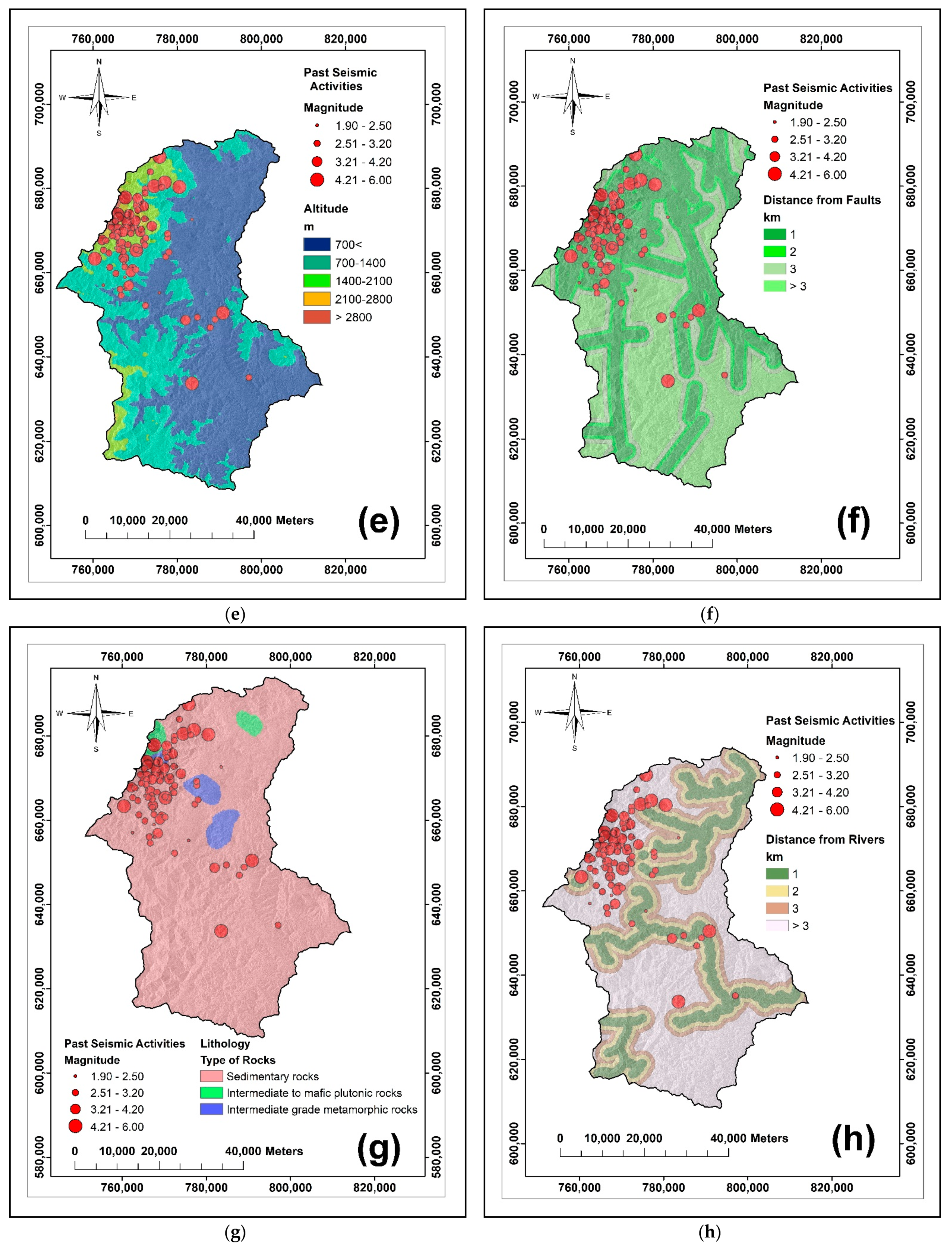
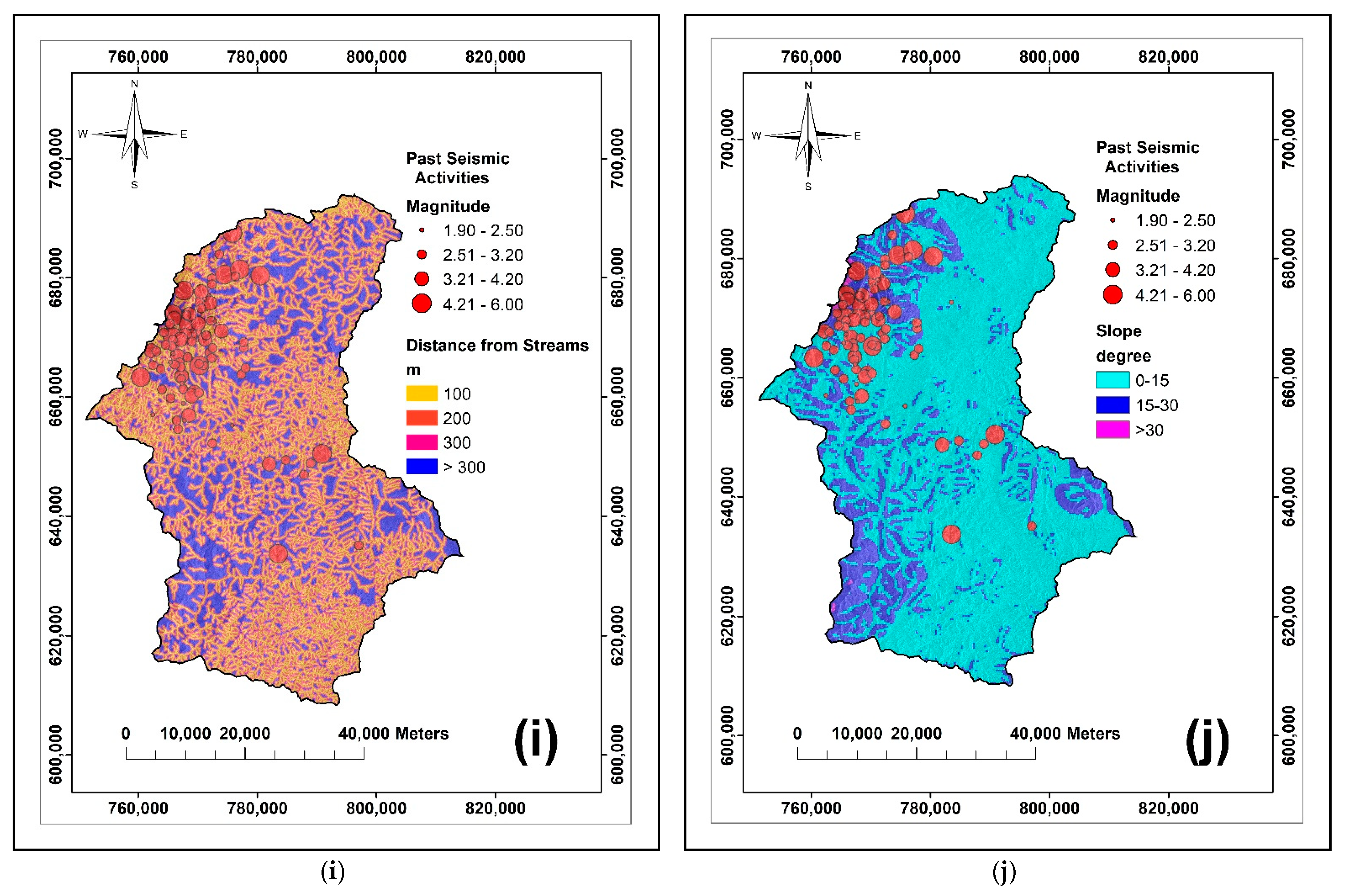
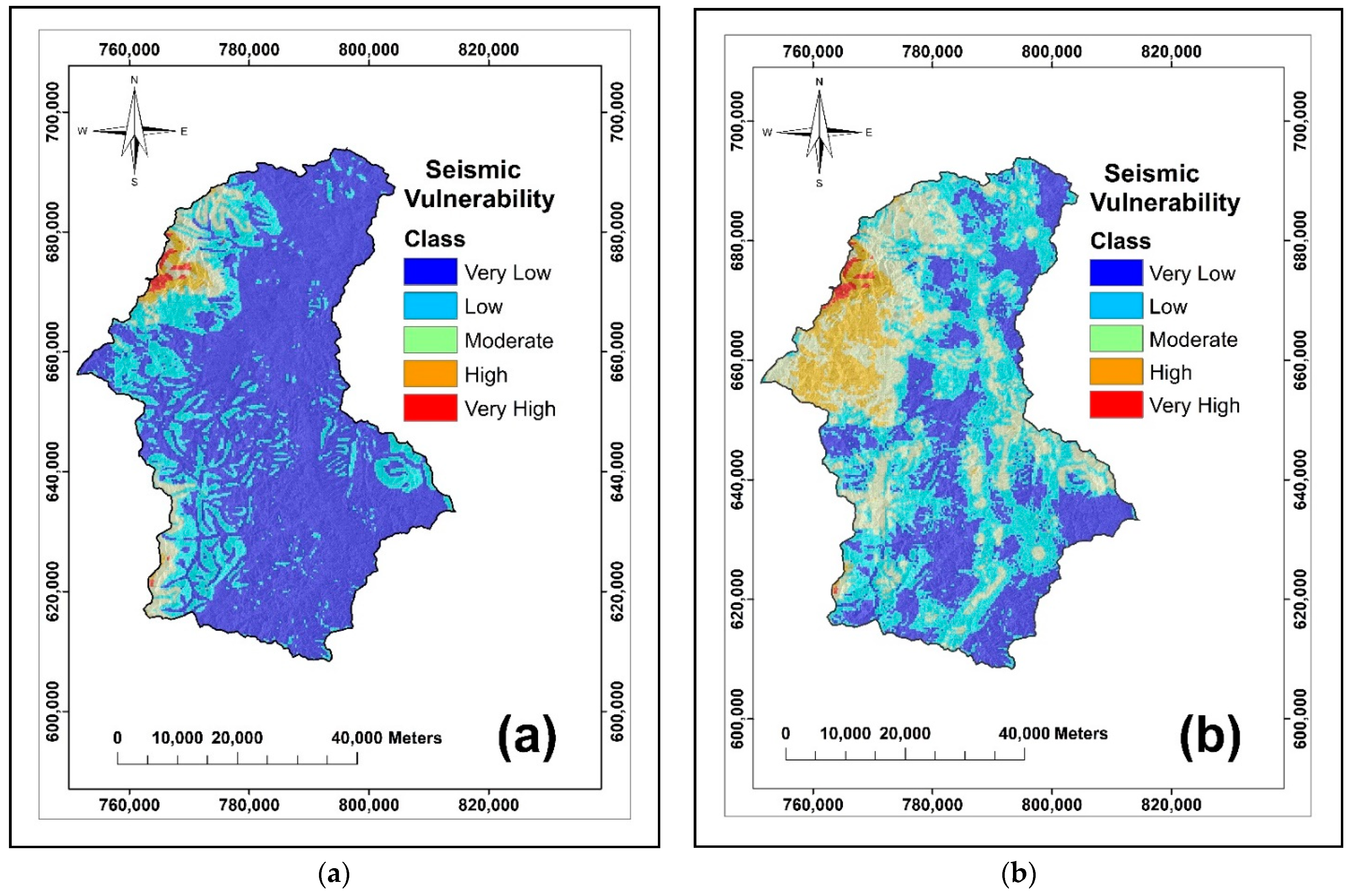
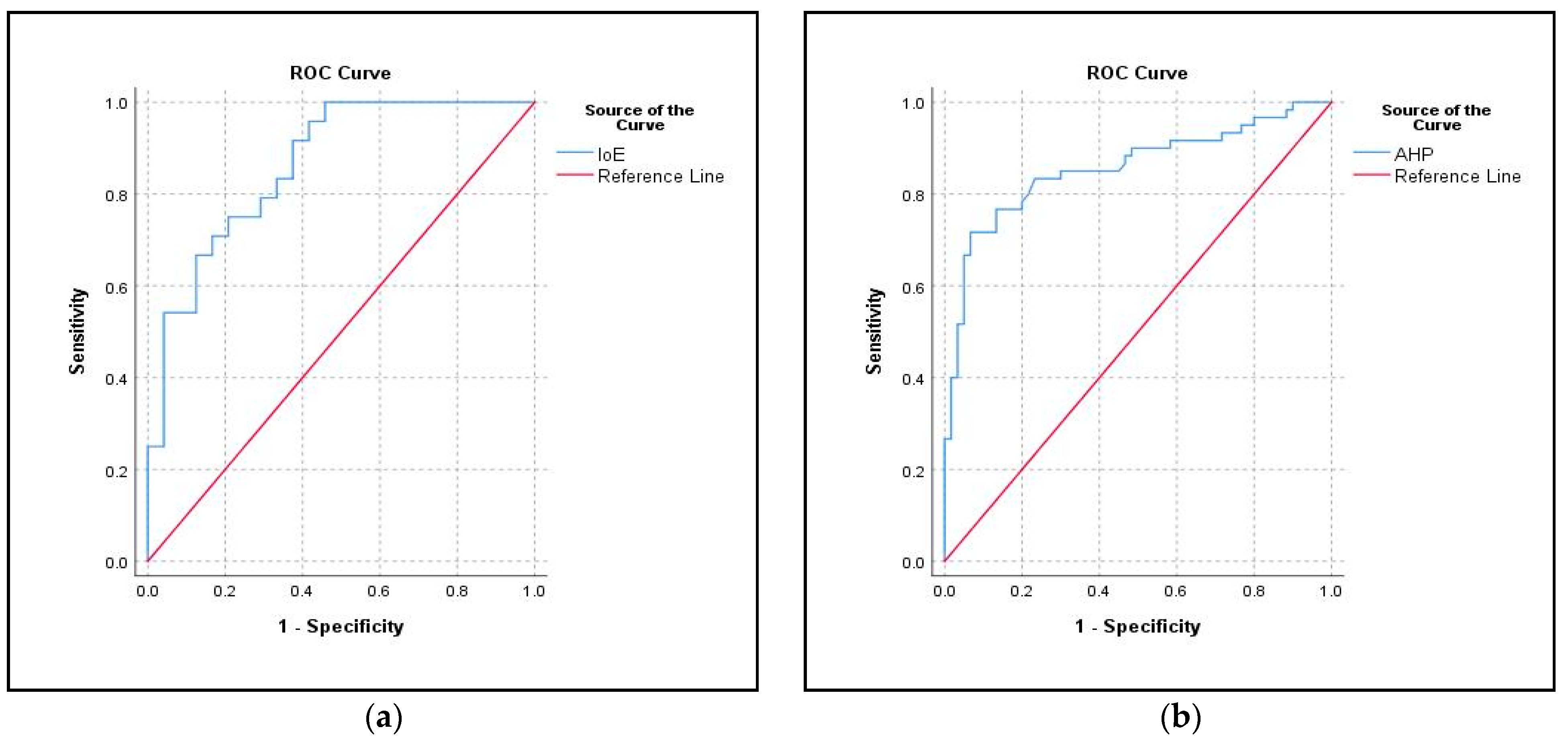
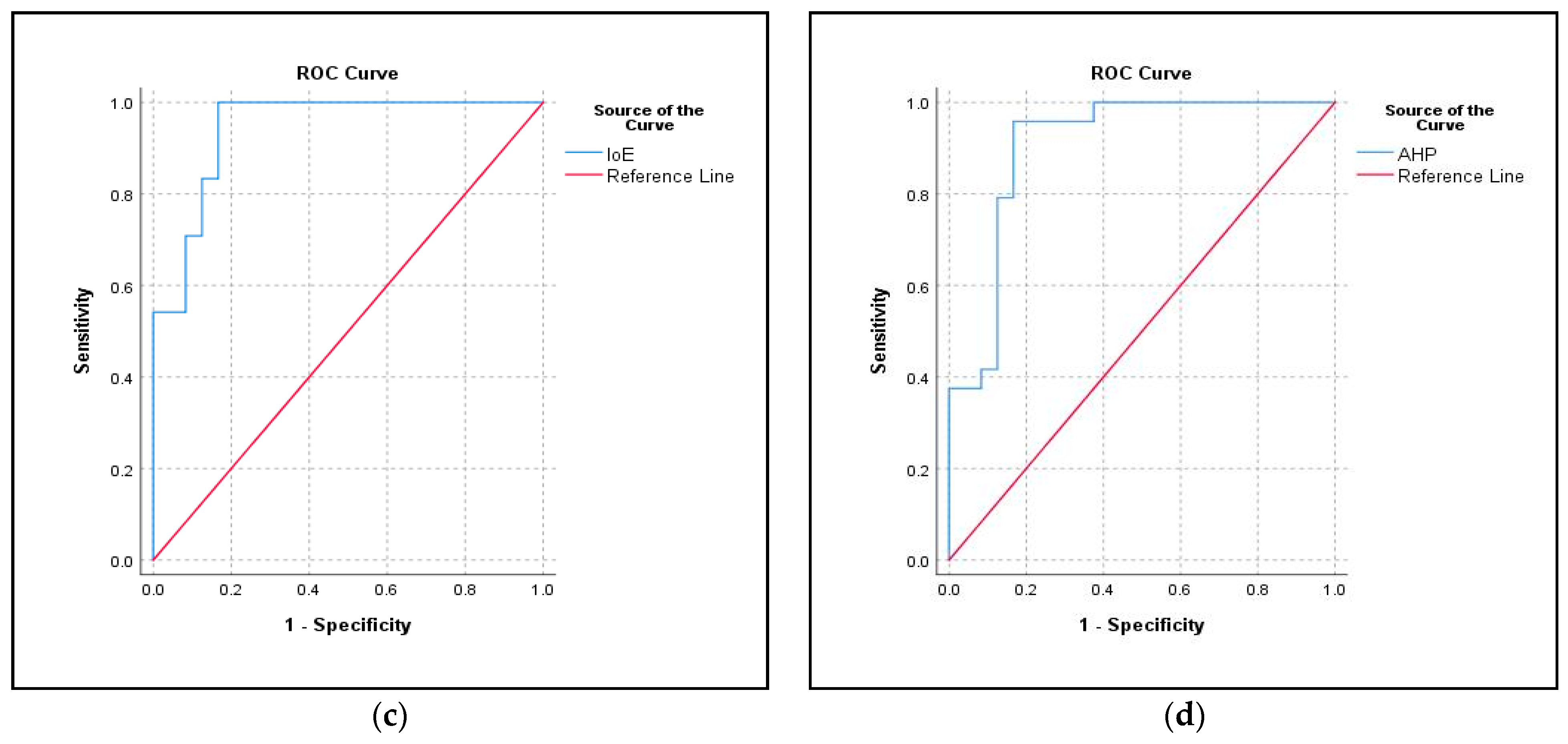
| Level of Importance | Definition |
|---|---|
| 1 | Equally Important |
| 2 | Equal to Moderately Importance |
| 3 | Moderate Importance |
| 4 | Moderate to Strong Importance |
| 5 | Strong Importance |
| 6 | Strong to Very Strong Importance |
| 7 | Very Strong Importance |
| 8 | Very to Extremely Strong Importance |
| 9 | Extreme Importance |
| N | RI | N | RI | N | RI |
|---|---|---|---|---|---|
| 1 | 0.00 | 6 | 1.24 | 11 | 1.51 |
| 2 | 0.00 | 7 | 1.23 | 12 | 1.48 |
| 3 | 0.58 | 8 | 1.41 | 13 | 1.56 |
| 4 | 0.90 | 9 | 1.45 | 14 | 1.57 |
| 5 | 1.12 | 10 | 1.49 | 15 | 1.59 |
| Conditional Factor | Class | a | b | Pij | (Pij) | Hj | Hj max | Ij | Wj |
|---|---|---|---|---|---|---|---|---|---|
| Distance from Buildings | 1 km | 0.157 | 0.450 | 2.857 | 0.416 | 2.203 | 2.585 | 0.148 | 0.169 |
| 2 km | 0.099 | 0.167 | 1.683 | 0.245 | |||||
| 3 km | 0.090 | 0.083 | 0.923 | 0.134 | |||||
| 4 km | 0.087 | 0.050 | 0.572 | 0.083 | |||||
| 5 km | 0.086 | 0.033 | 0.387 | 0.056 | |||||
| > 5 km | 0.479 | 0.217 | 0.452 | 0.066 | |||||
| Distance from Roads | 1 km | 0.301 | 0.250 | 0.831 | 0.188 | 1.956 | 2.000 | 0.022 | 0.025 |
| 2 km | 0.151 | 0.233 | 1.543 | 0.349 | |||||
| 3 km | 0.102 | 0.117 | 1.145 | 0.259 | |||||
| >3 km | 0.446 | 0.400 | 0.897 | 0.203 | |||||
| Distance from Tracks | 1 km | 0.347 | 0.517 | 1.489 | 0.358 | 1.903 | 2.000 | 0.048 | 0.050 |
| 2 km | 0.153 | 0.117 | 0.764 | 0.184 | |||||
| 3 km | 0.101 | 0.133 | 1.319 | 0.317 | |||||
| >3 km | 0.399 | 0.233 | 0.585 | 0.141 | |||||
| Altitude | 700< | 0.562 | 0.183 | 0.326 | 0.019 | 1.897 | 2.322 | 0.183 | 0.627 |
| 700-1400 | 0.335 | 0.350 | 1.046 | 0.061 | |||||
| 1400–2100 | 0.079 | 0.317 | 3.988 | 0.233 | |||||
| 2100–2800 | 0.017 | 0.117 | 6.854 | 0.400 | |||||
| >2800 | 0.007 | 0.033 | 4.927 | 0.287 | |||||
| Distance from Faulty Lines | 1 km | 0.334 | 0.550 | 1.646 | 0.428 | 1.698 | 2.000 | 0.151 | 0.145 |
| 2 km | 0.213 | 0.300 | 1.409 | 0.367 | |||||
| 3 km | 0.146 | 0.083 | 0.571 | 0.149 | |||||
| >3 km | 0.307 | 0.067 | 0.217 | 0.057 | |||||
| Lithology | Sedimentary Rocks | 0.944 | 0.917 | 0.971 | 0.266 | 1.512 | 1.585 | 0.046 | 0.056 |
| Intermediate to Mafic Plutonic Rocks | 0.019 | 0.017 | 0.899 | 0.247 | |||||
| Intermediate Grade Metamorphic Rocks | 0.038 | 0.067 | 1.776 | 0.487 | |||||
| Distance from Rivers | 1 km | 0.198 | 0.083 | 0.420 | 0.131 | 1.825 | 2.000 | 0.087 | 0.070 |
| 2 km | 0.166 | 0.083 | 0.502 | 0.157 | |||||
| 3 km | 0.142 | 0.117 | 0.824 | 0.258 | |||||
| >3 km | 0.494 | 0.717 | 1.452 | 0.454 | |||||
| Distance from Streams | 100 m | 0.306 | 0.367 | 1.199 | 0.303 | 1.960 | 2.000 | 0.020 | 0.020 |
| 200 m | 0.257 | 0.300 | 1.168 | 0.295 | |||||
| 300 m | 0.176 | 0.167 | 0.947 | 0.240 | |||||
| >300 m | 0.261 | 0.167 | 0.638 | 0.162 | |||||
| Slope Angle | 0–15 | 0.763 | 0.600 | 0.786 | 0.071 | 0.671 | 1.585 | 0.576 | 2.118 |
| 15–30 | 0.237 | 0.350 | 1.479 | 0.134 | |||||
| >30 | 0.006 | 0.050 | 8.755 | 0.794 |
| Conditional Factors | Wj | Rank | Weightage | Classes | Pij | Rank | Classes’ Weightage | Final Weight |
|---|---|---|---|---|---|---|---|---|
| Slope Angle | 2.118 | 1 | 0.306 | >30 | 8.755 | 1 | 0.724 | 0.222 |
| 15–30 | 1.479 | 2 | 0.193 | 0.059 | ||||
| 0–15 | 0.786 | 3 | 0.083 | 0.026 | ||||
| Altitude | 0.627 | 2 | 0.218 | 2100–2800 | 6.854 | 1 | 0.503 | 0.110 |
| >2800 | 4.927 | 2 | 0.260 | 0.057 | ||||
| 1400–2100 | 3.988 | 3 | 0.134 | 0.029 | ||||
| 700-1400 | 1.046 | 4 | 0.068 | 0.015 | ||||
| 700< | 0.326 | 5 | 0.034 | 0.008 | ||||
| Distance from Buildings | 0.169 | 3 | 0.154 | 1 km | 2.857 | 1 | 0.441 | 0.068 |
| 2 km | 1.683 | 2 | 0.220 | 0.034 | ||||
| 3 km | 0.922 | 3 | 0.145 | 0.022 | ||||
| 4 km | 0.572 | 4 | 0.094 | 0.014 | ||||
| >5 km | 0.452 | 5 | 0.060 | 0.009 | ||||
| 5 km | 0.387 | 6 | 0.040 | 0.006 | ||||
| Distance from Faulty Lines | 0.145 | 4 | 0.109 | 1 km | 1.646 | 1 | 0.506 | 0.055 |
| 2 km | 1.409 | 2 | 0.326 | 0.035 | ||||
| 3 km | 0.571 | 3 | 0.114 | 0.012 | ||||
| >3 km | 0.217 | 4 | 0.054 | 0.006 | ||||
| Distance from Rivers | 0.070 | 5 | 0.076 | >3 km | 1.452 | 1 | 0.569 | 0.043 |
| 3 km | 0.824 | 2 | 0.255 | 0.019 | ||||
| 2 km | 0.502 | 3 | 0.110 | 0.008 | ||||
| 1 km | 0.420 | 4 | 0.066 | 0.005 | ||||
| Lithology | 0.056 | 6 | 0.055 | Intermediate Grade Metamorphic Rocks | 1.776 | 1 | 0.681 | 0.037 |
| Sedimentary Rocks | 0.971 | 2 | 0.201 | 0.011 | ||||
| Intermediate to Mafic Plutonic Rocks | 0.899 | 3 | 0.118 | 0.006 | ||||
| Distance from Tracks | 0.050 | 7 | 0.037 | 1 km | 1.489 | 1 | 0.490 | 0.018 |
| 3 km | 1.319 | 2 | 0.305 | 0.011 | ||||
| 2 km | 0.764 | 3 | 0.126 | 0.005 | ||||
| >3 km | 0.585 | 4 | 0.079 | 0.003 | ||||
| Distance from Roads | 0.025 | 8 | 0.026 | 2 km | 1.543 | 1 | 0.558 | 0.014 |
| 3 km | 1.145 | 2 | 0.259 | 0.007 | ||||
| >3 km | 0.897 | 3 | 0.112 | 0.003 | ||||
| 1 km | 0.831 | 4 | 0.071 | 0.002 | ||||
| Distance from Streams | 0.020 | 9 | 0.019 | 100 m | 1.199 | 1 | 0.471 | 0.009 |
| 200 m | 1.168 | 2 | 0.284 | 0.005 | ||||
| 300 m | 0.947 | 3 | 0.171 | 0.003 | ||||
| >300 m | 0.638 | 4 | 0.074 | 0.001 |
| Seismic Vulnerability Class | FR-IoE Model | (FR-IoE) AHP Model | ||||
|---|---|---|---|---|---|---|
| Area (%) | Past Seismic Activities (%) | Seismic Activities Density Ratio | Area (%) | Past Seismic Activities (%) | Seismic Activities Density Ratio | |
| Very Low | 71.248% | 33.333% | 0.468 | 30.360% | 8.333% | 0.274 |
| Low | 21.900% | 31.667% | 1.446 | 40.049% | 13.333% | 0.333 |
| Moderate | 4.926% | 20.000% | 4.060 | 21.314% | 26.667% | 1.251 |
| High | 1.378% | 10.000% | 7.254 | 7.703% | 46.667% | 6.059 |
| Very High | 0.548% | 5.000% | 9.119 | 0.575% | 5.000% | 8.697 |
| Model Used | AUC Values | Standard Error | Asymptotic Significance | Asymptotic 95% Confidence Interval | |
|---|---|---|---|---|---|
| Lower Bound | Upper Bound | ||||
| Success Rate | |||||
| FR-IoE | 0.853 | 0.036 | 0.000 | 0.782 | 0.923 |
| (FR-IoE) AHP | 0.856 | 0.036 | 0.000 | 0.786 | 0.926 |
| Prediction Rate | |||||
| FR-IoE | 0.863 | 0.052 | 0.000 | 0.762 | 0.964 |
| (FR-IoE) AHP | 0.906 | 0.045 | 0.000 | 0.817 | 0.995 |
Publisher’s Note: MDPI stays neutral with regard to jurisdictional claims in published maps and institutional affiliations. |
© 2021 by the authors. Licensee MDPI, Basel, Switzerland. This article is an open access article distributed under the terms and conditions of the Creative Commons Attribution (CC BY) license (https://creativecommons.org/licenses/by/4.0/).
Share and Cite
binti Abd Razak, J.A.; bin Rambat, S.; binti Che Ros, F.; Shi, Z.; bin Mazlan, S.A. Seismic Vulnerability Assessment in Ranau, Sabah, Using Two Different Models. ISPRS Int. J. Geo-Inf. 2021, 10, 271. https://doi.org/10.3390/ijgi10050271
binti Abd Razak JA, bin Rambat S, binti Che Ros F, Shi Z, bin Mazlan SA. Seismic Vulnerability Assessment in Ranau, Sabah, Using Two Different Models. ISPRS International Journal of Geo-Information. 2021; 10(5):271. https://doi.org/10.3390/ijgi10050271
Chicago/Turabian Stylebinti Abd Razak, Janatul Aziera, Shuib bin Rambat, Faizah binti Che Ros, Zhongchao Shi, and Saiful Amri bin Mazlan. 2021. "Seismic Vulnerability Assessment in Ranau, Sabah, Using Two Different Models" ISPRS International Journal of Geo-Information 10, no. 5: 271. https://doi.org/10.3390/ijgi10050271
APA Stylebinti Abd Razak, J. A., bin Rambat, S., binti Che Ros, F., Shi, Z., & bin Mazlan, S. A. (2021). Seismic Vulnerability Assessment in Ranau, Sabah, Using Two Different Models. ISPRS International Journal of Geo-Information, 10(5), 271. https://doi.org/10.3390/ijgi10050271







